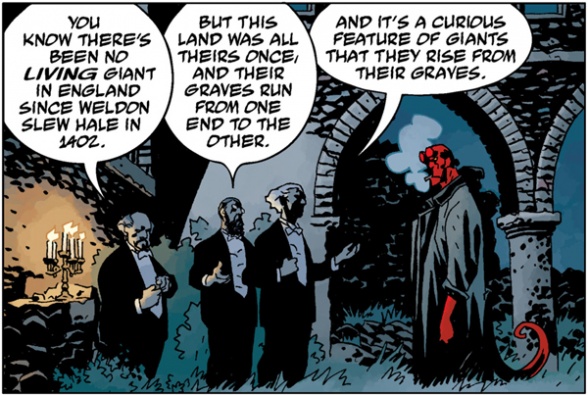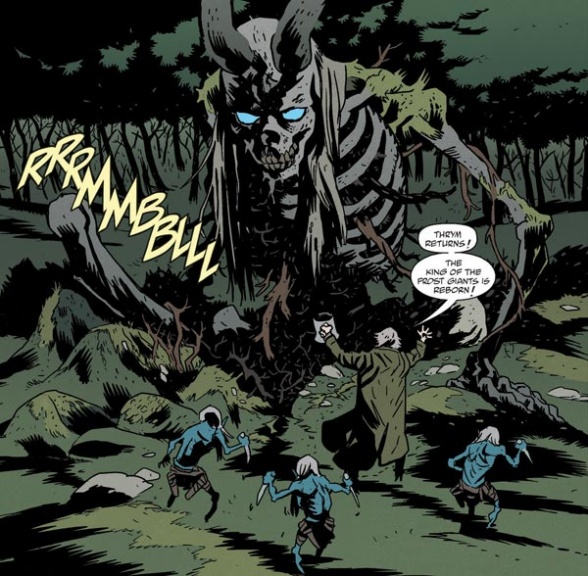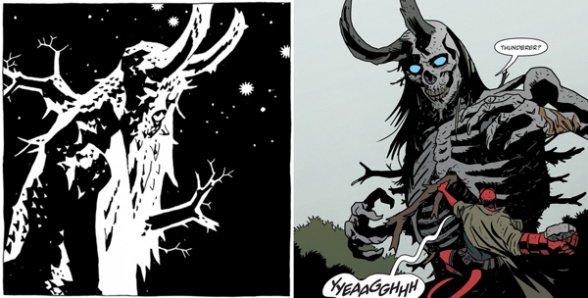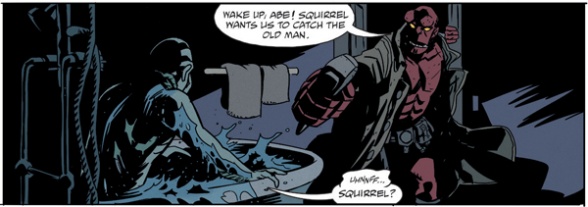
Welcome to Mignolaversity, Multiversity Comics’ dedicated column for all things Mike Mignola. We’re celebrating the twentieth anniversary of Christopher Golden and Mike Mignola’s Hellboy: The Bones of Giants novel and its new adaptation to comics with artist Matt Smith. As each new issue of the comic comes out, we’re exploring different aspects of the series. This month we’re talking to writer Christopher Golden and artist Matt Smith about design, both in terms of story design to fit into the larger Hellboy universe and in terms of visual design.
And in case you missed our previous interviews, here they are:
- “Hellboy: The Bones of Giants” announcement
- Adapting Giants – Part 1: Foundations of Prose
- Adapting Giants – Part 2: The Covers of Giants
It’s funny how back when Hellboy: The Bones of Giants was first written as an illustrated novel, it seemed like a standalone story. But time has a way of revealing the roots of the thing, and it’s tangled up with all sorts of foundational elements of the Hellboy Universe.
Back in 2001, we’d scarcely seen anything outside of our realm (Midgard)—just a few tantalizing glimpses of “Elsewhere.”

Art by Mike Mignola; colors by Dave Stewart; letters by Pat Brosseau
But in The Bones of Giants, Hellboy readers started to get an explanation for how these places beyond our realm fit together. Ragnarok (the Norse Ragnarok—distinct from the Ragna Rok in “B.P.R.D.: The Devil You Know”) fragmented reality. Some realms merged with Midgard and others exist outside it. “Elsewhere,” for the first time could perhaps be understood to be one of these fragments, tenuously connected to Midgard still.
Christopher, do you remember discussing this aspect of the story with Mike Mignola? What were those conversations like?
Christopher Golden: I don’t remember discussing that stuff at all, which is interesting to me. Mike and I have very different approaches to telling stories. I tend to over explain, partly because I’m always trying to figure things out in my mind. Maybe it’s that I want the audience to know that I understand what I’m trying to say. Working with Mike has allowed me to not feel that pressure so much. He always knows why certain things happen in his work, but he doesn’t feel the need to explain everything. Things happen and they are full of magic and sometimes so damn weird, but they’re rooted in some bit of folklore or in the mythology he has created in his own head, so what matters most is that HE knows. I’m pretty sure what happened with Ragnarok in this novel was that I needed to make it make sense to me, for myself. So anything I wrote in there about all of that would have been to that end. I’ve done similar things in other novels of mine that explore mythology or religion or faith, like The Ferryman, which was originally published in 2002, the year after The Bones of Giants. But if it all works out as part of the larger whole, I suspect that’s just a natural evolution, or serendipity, or because the Venn diagram of stuff I love and stuff Mike loves has a lot of overlap.
It shows how well suited to writing this universe you are when everything you wrote fits so nearly with what followed. Your explanation of fragmented realms could easily apply to Baba Yaga’s Russia or to England later. Since Hellboy: The Bones of Giants was published, newer stories have connected to so many elements it introduced. The Bones of Giants introduced us to Vigrid Field, where Thor fought Jormungand. . .

. . .but returning to it now, we know this is also the place where Hellboy died fighting Nimue in ‘The Storm and the Fury.’

Story by Mike Mignola; art by Duncan Fegredo; colors by Dave Stewart; letters by Clem Robins
It adds a new aspect to rereads, making a great story even better.
Continued belowIn light of this, when adapting the story to comics, were there moments you knew you had to include because of how much they’re a part of the Hellboy Universe at large now?
CG: I wish I could say I was focused on that, but the task of adapting this full length novel into eighty pages of comics, while giving Matt room to draw some of the things that inspired him to want to do it in the first place. . . well, that was my focus. I love that there is a greater echo, but I’d have needed more room to really take advantage of that. We really wanted to give readers the best experience of the original story as we could. That said, I do think that this later echo adds some flavor for people who are close readers.
Matt Smith: If I haven’t thanked Christopher before for giving me so many fun moments to draw, I want to do that on record now. Thanks, man! Can I go off road here and say how I enjoy hearing about how Christopher mentions his approach to writing and how he sees it in contrast to Mike’s? I really dig this kind of insight into the writing process. It puts me in mind of Twin Peaks and the relationship between David Lynch and Mark Frost. It’s only the thinnest of comparisons as we’re talking about very different animals, but there you have Frost building out the story structure and Lynch having more visual ideas and not being concerned about making everything clear for the audience. They both are creative forces and they both are powerful storytellers, but one is more of a picture guy (Lynch being a painter) and one is more of a word guy. That kind of collaboration of two can yield fantastic results as one strengthens the other. It clearly did in The Bones of Giants novel.
Of course, a big part of ‘The Bones of Giants’ involves the Frost Giant Thrym rising from the dead. This fits very nicely with a story element from “Hellboy: The Wild Hunt.”

Story by Mike Mignola; art by Duncan Fegredo; colors by Dave Stewart; letters by Clem Robins
But Thrym is on another level. The ones in ‘The Wild Hunt’ caused only a minor fuss when compared to Thrym. When he rises from his grave, he’s just bones, and to restore himself, he gorges on anyone unlucky enough to be in his path. So could you tell us about Thrym’s visual development from Christopher Golden’s descriptions in the book and Mike Mignola’s illustrations, to designing him for the comic and his various stages of resurrection?
CG: Yeah, I’d love to get Matt’s thoughts on this! Thrym is definitely on another level. He was the king of the Frost Giants of Norse myth and that’s no ordinary giant of legend. Also, Thrym has been resurrected via magic by Professor Aickmann, so there’s another level to that as well. I just loved the idea of his corpse that’s been somehow buried in Sweden for so long that massive, ancient trees grow out of the bones of its chest.
Excerpt from Hellboy: The Bones of Giants, Chapter 9:
So when Thrym stood, dirt showered down around him but three trees remained, jutting like killing arrows from his chest, roots wound up through the bones, so bleached and gray that it was almost impossible to know what was bone and what was wood.

The one exchange Matt and I definitely had about that was the size of Thrym. Matt makes it look easy, but it is absolutely not a simple thing to have Hellboy fighting giants who are as big as these and still manage to get the scope of it onto the page. We had to find a height that would be as large as we could manage it on the page and not lose track of the one-on-one quality of the first fight between them, or the final one.
MS: Yes, that was a good challenge—how to suggest a significant scale difference and to be able to keep that drama between them. They need to be able to interact in a way that is readable. I’m basically repeating what Christopher just said. Ha! So much for looking forward to what I had to add to the discussion! My goal is always that things read clearly and look cool and so I tried to keep the scale difference consistent but I also wasn’t going to sweat it so much that it would cause the drawings to get stiff or lose the feeling of the conflict between them. If I did my part right, you’ll get the immense size of Thrym but you won’t lose the close-up drama.
Continued below
Right: Thrym in “Hellboy: The Bones of Giants” #3
Yeah, I can see how you pushed the scale of Thrym by having him crouched as he emerges from his grave early on, then later, when he’s standing at his full height, he’s framed from the waist up with Hellboy leaping through the air.
MS: I thought of this with the Jormungand/Thor fight in issue #1 as well. If you take Jormungand’s description literally, that he can circle the entire earth, then he is rather big. It’s easy enough to put Thor on a hillside in the foreground and a massive snake on the horizon but when the two actually need to engage in battle, that’s where you have to start working with the scale difference for real. How do you understand what is happening if it’s close up enough to see the smaller combatant clearly, what can you make out of the larger one? Your other option is to pull way back and have the small guy super tiny and then you can lose that feel of the moment. I’m not saying it can’t be done well, it has been, but I have to work within my own limitations and how I can understand those scenes, moving the camera around if you will.
‘The Bones of Giants’ is much more of an urban fantasy than we’re used to seeing in “Hellboy.” I don’t recall ever seeing him in cars and helicopters so often. And Hellboy runs around the streets of Stockholm—not a strange, haunted corner that’s strangely detached from the era, but regular 1988 Stockholm. In terms of the story, it makes for powerful visuals throwing Hellboy into such an environment, and it makes the contrast between his world and where he ends up in issue #4 so much more striking.
Matt, was it a particular challenge for you to take on the urban side of this story? I know Duncan Fegredo has mentioned the difficulty of drawing Hellboy in a car. Did you run into things like that?
MS: Oh yeah, it was a challenge for sure. I don’t know how much anyone wants to hear about my personal trip into comics, but it started with a plan to only draw barrel-shaped barbarians wandering around mountains where the only perspective was atmospheric. I’ve had a bit of stretching out what I thought I could pull off since then, particularly in “Folklords” where there were hints of the “real world” bleeding into a medieval-looking fantasy environment, but never really attempted a story before with so much of it set in the modern world. That contrast is something central to the character, that he always has a hoof planted in two different worlds, and that’s something I love about the series. I just never really thought through having to draw the modern stuff until it came time to do it. I suppose when I thought about that contrast before, it was mostly about Hellboy bringing his modern sensibilities and personality into those haunted corners but not so much seeing him in the normal world, if that makes sense. I ended up enjoying that part, though, surprisingly enough. Trying to put Hellboy in a nice living room or Abe in a bathtub.

Duncan made it look easy but I’m not surprised to hear that it wasn’t. He tackled incredibly complicated sequences and made them beautifully clear and dynamic. Really just incredible what he did with that car scene and the Hedgehog champion. I’m never not stunned by it.
Of course, the other side of this story is all the elements from Norse mythology. And I know you love Norse mythology. So when it came time to do the research for this story, how much was homework and home much was just for the fun of it? What cool things did you discover and incorporate?
MS: Just as you say, I loved Norse mythology for some time now and I think I had the benefit of an accumulated visual library from reading the stories, listening to the records of bands into this stuff, reading comics, films, etc. over the years—so that this imagery is just kind of grafted into my head. In that sense, it wasn’t so much of having to research but just trying to make it work for this story.
Continued below
Right: Eitri and Brokk in “Hellboy: The Bones of Giants” #2
For example, the dwarves. I’d probably sketch a dwarf in a more complicated way on my own for fun, but here my thinking was—can I make it so they are all distinct and recognizable in some way, at least a few of them so we know who lives and dies and maybe we care about them a bit? So it’s filtering the visual library of Norse mythology through a lens that’s focused on making it all read clearly and work for this story, that’s really where the effort came in. But yeah, it’s Norse mythology, so it’s all fun and cool to me!
We’ll have the final installment of Adapting Giants soon. Look for it in February after “Hellboy: The Bones of Giants” #4 comes out on February 9.
Written by Christopher Golden and Mike Mignola
Illustrated by Matt Smith
Colored by Chris O’Halloran
Lettered by Clem RobinsHellboy and the others make their way to the ghost city of Utgard in search of Thrym. But there’s more than one giant standing between the B.P.R.D. and saving the world. Dwarves, Valkyries, and the Norse god of Thunder himself come together for the ultimate confrontation to close out this stunner of a series!







